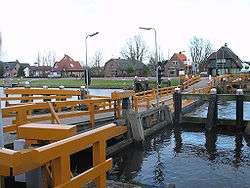Noordhollandsch Kanaal
The Groot Noordhollandsch Kanaal (Great North Holland Canal), now known simply as Noordhollandsch Kanaal, is a canal in the northwest Netherlands. The canal stretches about 75 kilometres, connecting several cities in North Holland: from Den Helder in the north, through Alkmaar and Purmerend, to Amsterdam at its southern end.
A unique element of the canal are the floating bridges, so-called vlotbruggen ("raft bridges"). These bridges were constructed because engineers in the 1820s, when the canal was constructed, were not able to build bridges long enough to span the canal. The bridges opened by sliding the floating middle sections underneath the fixed end sections.
History
The Noordhollandsch Kanaal was dug to shorten the sea route to Amsterdam. Also, the city's harbour was becoming inaccessible to seafaring ships due to the increasing number of shoals and shallows in the Zuiderzee. Construction of the canal was begun in 1820 and completed in 1824. The project was part of King Willem I's efforts to revitalize the country's once-flourishing trade and industry following the destructive French revolutionary and Napoleonic era. The canal connected a number of existing waterways, including various canals and the small Rekere river. At either end of the canal, sluice gates were built: the Koopvaardersschutsluis at the northern (Den Helder) end, and the Willem I-sluis at the southern (Amsterdam) end.
The canal soon proved inadequate due the growing size of ships, the many bridges and sluice gates and the many curves and turns in the canal. Also, the canal froze in winter. It was therefore decided to dig a new canal, the North Sea Canal, between Amsterdam and IJmuiden. Completed in 1876, it made the Noordhollandsch Kanaal largely obsolete. Though still used for commercial shipping, the Noordhollandsch Kanaal's main functions today are recreation and water management.
 Floating bridge across the canal |
 The canal near Alkmaar |